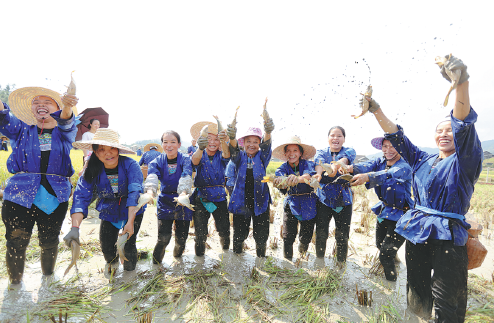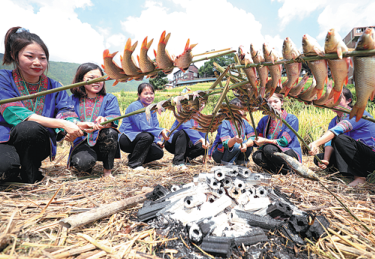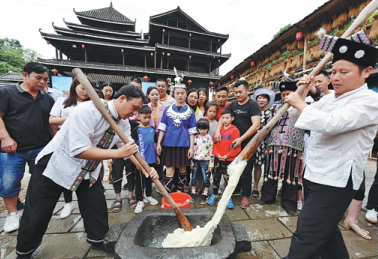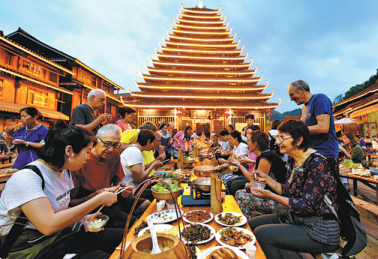Fishing for a prosperous catch

Ethnic Dong women catch fish in the paddy fields in the Sanjiang Dong autonomous county in the Guangxi Zhuang autonomous region. WU LIANXUN/FOR CHINA DAILY
New method by farmers is helping harvest a tourism wave in South China's Guangxi Zhuang autonomous region, Yang Feiyue reports.
The fall harvest is always a picturesque time in the Sanjiang Dong autonomous county.
Farmers are busy harvesting the rice paddies amid the golden farmland and fishing the ponds in October, and the air was filled with joy and optimism for a big harvest in the county, in South China's Guangxi Zhuang autonomous region.
Wei Fahong seems content with the harvest from his family's farmland of 3 mu (0.2 hectares) in Linlue village of Sanjiang.
He reaped more than 1,500 kilograms of rice, which will bring his family an income of more than 10,000 yuan ($1,566).
Amid the high wheat straw in the pond, fish were fattened perfectly for the dining table.
Some farmers already celebrated harvest ahead of time with fresh roast fish.
"It's harvest season, and having fish is an auspicious practice that expresses our wish for a surplus harvest," says Shi Shilian, a villager from Sanjiang.
In Chinese, the word surplus and fish are pronounced the same.
"It's a good way to celebrate our gains," Shi says.
Sanjiang county is home to the ethnic Dong people, accounting for 57 percent of the local population. Locals have relied on paddies and fishing for a living since ancient times.
The fertile land, rich water resources and pleasant climate make things ideal for the agricultural development.

The catch is grilled over an open fire to celebrate harvest. WU LIANXUN/FOR CHINA DAILY
The symbiosis of the two brings the benefits as the fish eat pests and microorganisms that are bad for the rice, while producing fertilizer for the crop, according to the local authority.
The county was named a demonstration zone for standardized fish culture in paddy fields earlier this year. The authority has come up with standards for all links in the fish culture chain.
The standards have helped increase production of paddy rice and fish, improving their popularity among consumers, says Hou Menglin, director of the Sanjiang market supervision bureau.
The method has enabled locals to produce premium, high-quality rice and fish, both of which have helped to draw visitors from the city.
They can go fishing and grill their catch, while taking in the distinctive rural and ethnic culture as they enjoy the unrivaled hospitality of Sanjiang.
The Chengyang Bazhai scenic area in Sanjiang comprises eight villages with more than 10,000 Dong residents and features a rich ethnic culture.
It allows visitors to get a fascinating glimpse into the well-preserved ancient traditions of the ethnic group, including its songs, dances, religious beliefs, folk customs and textile skills.
The historical bridges and typical wooden buildings with Dong characteristics are picture perfect, especially the drum towers and houses on stilts.
The Yongji Bridge, for instance, features pagodas and pavilions across its span. Completed in 1912, it is typical of many local artistic structures, some of which can boast a history stretching back more than 2,000 years. It was named among the world's top 10 most spectacular bridges by the American Broadcasting Co in 2008.
From January to July, Sanjiang received a total of 5.71 million visits, up 124 percent year-on-year; and tourism revenue reached 6.7 billion yuan, up 125 percent year-on-year.

Visitors watch Dong people pounding the dough for ciba, a glutinous rice food. GONG PUKANG/FOR CHINA DAILY
As of 2020, a total of 25,000 people in Sanjiang had engaged in the tourism industry by offering various related services, including running rural homestays and selling local farm produce.
Tang Xinguang from Dashu village was one of the first to answer Sanjiang's call to take up rice production and fish farming.
He rented idle land from villagers and applied the new agricultural standards. At the same time, he got help in promoting the farm's produce via e-commerce and various agriculture expos.
"The standardized paddy-field-fish-culture has spread in our village," Tang says, adding that the area dedicated to the farming technique has expanded from 9 hectares to more than 30 in Dashu.
Many locals have opened rural restaurants serving a feast of fish for visitors.
To date, Sanjiang has built five paddy and fish culture demonstration bases, which altogether cover an area of more than 190 hectares.
A total of 52 kilograms of fish and 460 kilograms of paddy rice can be obtained per mu (0.07 hectares) of land, says Wu Chengdong, deputy head of Sanjiang county.
It will increase per mu income by more than 3,000 yuan, Wu adds.
The local authority has rolled out a plan to upgrade paddy and fish farming technology. It's aiming to develop a cultivation area of about 4,700 hectares over the next three years.
The goal is to increase per capita annual income by 1,000 yuan in the county.
Some villages have consolidated their farmland base and dug fishponds on the side.
"The advantage of this is that it can support ratoon cropping (pruning the part of the crop that sits above the waterline but leaving the roots intact, to encourage recovery and stronger yield the following season), prolonging the growth period of the fish," says Wu Xin, a village official.
"It ensures the quality of fish while promoting the stable yield of rice," he says.
The improved agricultural development has paved the way for tourism as Sanjiang county continues to integrate agriculture with its ethnic festivals.
"The benefit of planting alone was minimal, and many people were unwilling to plant, resulting in the serious problem of a lot of abandoned paddy fields," Wu Chengdong says.
"If we do a good job with the infrastructure of paddy fields, and combine aquaculture with tourism, we can not only solve the problems of land waste and food security, but also improve soil stratification and environmental sanitation," he says.

Tourists from home and abroad enjoy traditional Dong food during a festival banquet. GONG PUKANG/FOR CHINA DAILY
